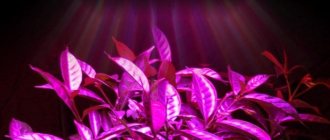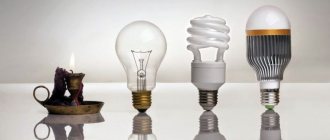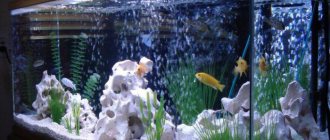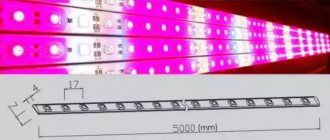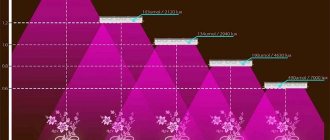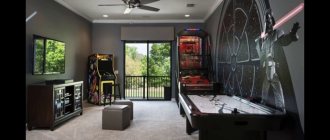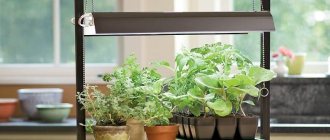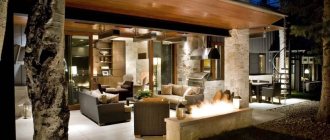A decrease in natural insolation in winter leads to light starvation of indoor plants and a decrease in the intensity of photosynthesis. LED lighting for plants and flowers solves this problem, but you need to know how to choose it. Let's look at how to choose an LED lamp for plants and make it yourself.
When there is insufficient illumination, photosynthesis processes are inhibited, which inevitably leads to growth inhibition. The stems become thinner and stretch towards the main source of light. During the period of abundant flowering, lack of lighting leads to the unauthorized release of buds.
LED lighting - main characteristics
The advantages of using LED lighting include, first of all, a long service life, no heating during operation, and low electrical energy consumption. In addition, you can create lighting of the required spectrum - for example, using blue and red LEDs.
LED lighting for plants
To create conditions that are natural and favorable for growing, the illumination should be no less than:
- 700 – 1,000 lux – for plants growing in the shade;
- 1,000 - 2,000 lux - for plants that can grow in the shade and prefer diffused light;
- 2,500 lux and more - for light-loving plants.
To calculate a lighting system using LEDs, you need to know the following quantities:
- Illuminated area;
- Installation height of lamps;
- Type of plant (relation to light).
Lighting power is determined in watts per m2. The most useful light waves for plant development are blue and red. Depending on the parameters, light waves have different effects on plants, namely:
| Item no. | Light waves | Wave range, nm | Impact on plants |
| 1 | Ultraviolet | 400 | Promotes resin formation |
| 2 | Infrared | 730 | Helps produce chlorophyll |
| 3 | Blue color | 430 | Helps produce chlorophyll |
| 4 | Red color | 660 | Helps produce chlorophyll |
Blue LEDs
LEDs of this color emit a luminous flux of the blue, blue-violet spectrum, lying in the range from 430 to 490 nm. This light spectrum has a positive effect on plants in the initial growth stage.
Red LEDs
LEDs of this color emit a luminous flux of the red, red-orange spectrum, lying in the range from 600 to 780 nm. This light spectrum has a positive effect on plants at the stage of fruit development and leaf growth.
Full Spectrum LEDs
Phyto LEDs, full spectrum LEDs, are devices that emit an extended range of light waves from a single light source.
Phyto LEDs
Advantages of this type of device:
- The emitted luminous flux is close in characteristics to natural sunlight (range from 400 to 840 nm);
- Suitable for all stages of plant growing;
- Allows you to simultaneously illuminate plants of different development stages.
- The efficiency of use is higher than when using individual LEDs with a narrow spectrum of light emission (1.9 times) and LED assemblies (1.2 times).
Result:
What conclusions did I draw for myself?
1. Not all yoghurts are equally useful. In this case, cheap LEDs on Epiled crystals turned out to be less effective for plant growth and there is no point in using them. Apparently, in addition to cheap crystals, they use a lower-quality phosphor, otherwise there is no way to explain how they give worse results at higher power.
2. And the opposite conclusion is that an expensive product is not always a guarantee of quality. I don't want to say anything bad about the American company Bridgelux. Most likely, everything I'm dealing with is a fake. The characteristics of this “Bridgelux” and Epiled are too similar. These expensive phyto-LEDs are no better than their cheap counterparts.
3. For illuminating plants, ordinary white LEDs are quite suitable, providing growth on an equal basis with special ones, both with single crystals of 660 and 445 nm, and phosphors with a “full spectrum”
4. Careful selection of components on Aliexpress allows you to make a more or less optimal choice. Thus, Epistar “full spectrum” LEDs, as per the link to the product in this topic, allow for plant growth with a 20% reduction in lamp power relative to white LEDs.
Everything stated in this article is my personal observations and experience.
For more accurate results, much more research using instruments is needed. What criteria does a cat use to evaluate grass remains a mystery to me?
Types of LED light sources
Currently, a large number of different types of LED lamps (luminaires) are produced, which can be classified as:
- In the form of a pipe - convenient to use when growing plants at home;
- Single spotlight - there are various designs, used for individual use;
- LED panel - used to illuminate a large number of plants, they come in rectangular shape;
- LED strip is universal in use and easy to install. When making LED strips used to illuminate plants, the number of blue LEDs to red ones is 10/3, 15/5, 5/1, respectively. In LED phyto lamps, the proportion of red color is 60-80%, and blue – 40-20%. ;
- LED floodlight is a device for industrial use. It is possible to illuminate large areas from a remote distance.
LEDs are narrowly focused light sources, which determines the conditions for their installation. When installing luminaires, you should consider:
- Plant height;
- Arrangement of plants (distance between them).
Application experience
- Yaroslav, 26 years old. Saint Petersburg. “I installed a lamp with two rows of LEDs: red and blue lamps. I was pleased with the result: the plants became stronger and more fruitful. I recommend these lamps for light culture.”
- Svetlana, 42 years old. Nizhny-Novgorod “I am engaged in breeding light-cultured plants. I specially installed a lamp with blue and red lamps from the manufacturer Artleds. Within a few days I noticed that the flowers had acquired a richer color, the stems became stronger and the leaves stopped turning yellow at the edges.”
- Irina, 22 years old. Moscow “I specialize in growing flowers for sale. For greater efficiency, I installed LED lamps that help the flowers always be in excellent condition. I advise all flower growers not to skimp on proper lighting.”
- Andrey, 34 years old, Tyumen “I’ve been using LED lamps for several years now. At first I was skeptical, but from my own experience I was convinced of the effectiveness of such lighting. The main thing is to position the lamp correctly and water the flowers in a timely manner.”
Artificial lighting is a good way to have a beneficial effect on the growth and flowering of indoor flowers in winter , as well as in rooms where light does not penetrate well.
Of great importance in lighting is the spectrum, the height of the suspension and the illumination mode of the plants.
If you want your indoor flowers to be healthy and beautiful, you need to take into account the light parameters and the need of certain types of plants for artificial LED lighting.
LED Lighting Manufacturers
Currently, the light source market offers a fairly wide range of LED lamps that differ in design, power, type of performance and their manufacturer. The most famous are:
"Komled", Kazan, Russia is a manufacturing company specializing in the production of LED lamps for various purposes. For plant lighting the following are available:
- “Optima F” lamps – power from 38.0 to 220 W and luminous flux from 3036 to 18216 Lm, respectively;
- “Line F” lamps – from 10.0 to 65.0 W and luminous flux from 1331 to 9318 Lm, respectively.
"SVETOTRONIKA", St. Petersburg, Russia - the company produces a wide range of LED lamps of various designs and purposes. For lighting plants, lamps with a power of 50 Watt are produced, with a luminous flux of 79.3 µmol/s lumens and a color temperature of 450 nm - 32% (8 diodes) and 660 nm - 68% (16 diodes):
- SVT-BIO L-50-45;
- SVT-BIO L-50;
- SVT-BIO L-50-20×50;
- SVT-BIO L-50-10×60;
- SVT-BIO L-50-25;
Largest foreign manufacturers:
- Nichia Corporation, Japan;
- Samsung LED, South Korea;
- Osram Opto Semiconductors, Germany;
- LG Innotek, South Korea;
- Seoul Semiconductor, South Korea;
In addition to those listed above, LEDs from lesser-known domestic and foreign manufacturers are also available on the domestic market, so anyone can choose an LED lamp in accordance with the requirements for it.
DIY LED lighting for plants
LEDs for creating a lamp
If you have electrical installation skills, free time and desire, you can make LED lighting yourself, so to make a phyto lamp you will need:
- Fluorescent lamp housing;
- Power supply 220/12 V, you can use a used one;
- LED matrices or LEDs;
- Connecting wires (copper, cross-section not lower than 0.75 mm2);
- Cooling plate (cooler);
- Aluminum strip.
LEDs of selected colors (the colors and their relationships are given above) are attached to the LED matrix or connected in parallel, using connecting wires or soldering, in accordance with the polarity of the devices.
The number of LEDs connected (their total power) must correspond to the power of the power supply. Mounting is carried out on the cooling plate. Also, to cool the LEDs, ventilation holes are made in the lamp body by drilling. In the case of using an LED matrix, the light source is glued to an aluminum strip, which is placed inside the lamp body.
Natural experiment
To do this, I assemble small phytolamps on an aluminum profile
In a lamp with a separate spectrum I put three red 660nm and one blue 445nm. This amount approximately equalizes the power of the lamp with the others, since the drop on the red crystal is only 2.5V with the corresponding power. I power all five lamps in series with one 36-watt crystal driver.
Due to different voltages on different crystals, the power spread was about 20%
As a “guinea pig” I choose grass for cats that has rapid germination and growth. Yes, and you can please the cat
I'm looting a landfill in a dark corner of the room. Planted it, watered it, let's go!
About a day later the grass came up. We start illumination in a round-the-clock mode (not entirely correct, of course, but for the speed of the experiment)
A couple of days - the grass reached towards the light. More or less evenly.
But on the fifth day the difference is already quite visible. The cat happily follows the development of the experiment.
On the 7th day I complete the experiment. As they say, the result is obvious
Two clear outsiders have emerged - Epiled and Bridgelux. The difference in grass growth was more than 25%.
Before summing up, I would like to summarize the cost of one LED for a batch of 50-100 pcs.
